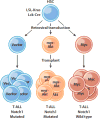The Varied Roles of Notch in Cancer
- PMID: 27959635
- PMCID: PMC5933931
- DOI: 10.1146/annurev-pathol-052016-100127
The Varied Roles of Notch in Cancer
Abstract
Notch receptors influence cellular behavior by participating in a seemingly simple signaling pathway, but outcomes produced by Notch signaling are remarkably varied depending on signal dose and cell context. Here, after briefly reviewing new insights into physiologic mechanisms of Notch signaling in healthy tissues and defects in Notch signaling that contribute to congenital disorders and viral infection, we discuss the varied roles of Notch in cancer, focusing on cell autonomous activities that may be either oncogenic or tumor suppressive.
Keywords: Notch; cancer hallmarks; cellular transformation; oncogene; tumor suppressor.
Conflict of interest statement
DISCLOSURE STATEMENT
J.C.A., W.S.P., and S.C.B. do not have any conflicts of interest to disclose.
Figures








References
-
- Hamada Y, Kadokawa Y, Okabe M, Ikawa M, Coleman JR, Tsujimoto Y. Mutation in ankyrin repeats of the mouse Notch2 gene induces early embryonic lethality. Development. 1999;126:3415–24. - PubMed
Publication types
MeSH terms
Substances
Grants and funding
LinkOut - more resources
Full Text Sources
Other Literature Sources

